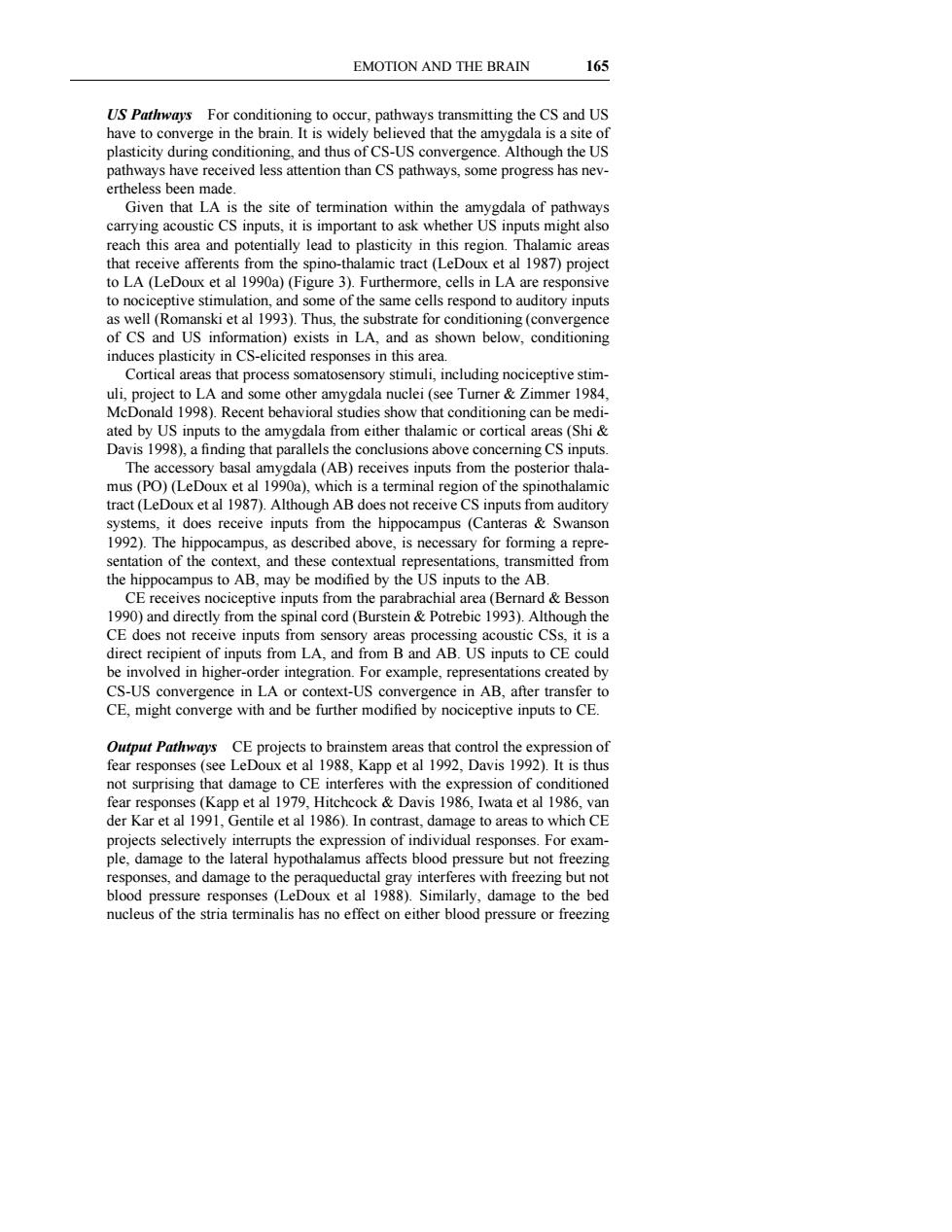正在加载图片...

EMOTION AND THE BRAIN 165 US Patwys For conditioning to occur,pathways transmitting the CS and US have to converge in the brain.I ertheless been made. Given that LA of termination withir ach this nd no ntially lead to plasticity n this Thalamic a that receive afferents from the spino-thalamic tract (LeDoux eta 1987)project Leoueta )()h na to au itory input induces plasticity in CS-elicited responses in this area. that process somalosen MeDooald 1998)ge hat co ated by US inputs to the amygdala from either thalamic or cortica areas(Shi Davis 1998),a finding that pa allels the conclusions above con ceming CS inputs mus (PO)( (receives inputs from the tract (LeDoux etal 1987).Although AB does not receive CS inputs from auditor systems.it does receive inputs from the hippocampus (Canteras&Swansor 1992).The the hi mpus to AB ay he uts to the AR CE receives nociceptive inputs from the parabrachial area(Bernard&Besson ough the oes no nd f areas 1A order integration for example repre entations created by CS-US convergence in LA or context-US convergence in AB.after transfer to CE,might converge with and be further modified by nociceptive inputs to Ch roieets to brainstem areas that control the ion of fear responses (see LeDoux et al 198,Kapp et al 1992,Davis 1992).It is thus not surprising that dam age to C 山the86 ression of conditione In oiects selectively interrunts the exnr sion of individual resp nses for exam ple,damage to the lateral hypothalamus affects blood pressure but not freezing and damage to th peraque with freezing butn EMOTION AND THE BRAIN 165 US Pathways For conditioning to occur, pathways transmitting the CS and US have to converge in the brain. It is widely believed that the amygdala is a site of plasticity during conditioning, and thus of CS-US convergence. Although the US pathways have received less attention than CS pathways, some progress has nevertheless been made. Given that LA is the site of termination within the amygdala of pathways carrying acoustic CS inputs, it is important to ask whether US inputs might also reach this area and potentially lead to plasticity in this region. Thalamic areas that receive afferents from the spino-thalamic tract (LeDoux et al 1987) project to LA (LeDoux et al 1990a) (Figure 3). Furthermore, cells in LA are responsive to nociceptive stimulation, and some of the same cells respond to auditory inputs as well (Romanski et al 1993). Thus, the substrate for conditioning (convergence of CS and US information) exists in LA, and as shown below, conditioning induces plasticity in CS-elicited responses in this area. Cortical areas that process somatosensory stimuli, including nociceptive stimuli, project to LA and some other amygdala nuclei (see Turner & Zimmer 1984, McDonald 1998). Recent behavioral studies show that conditioning can be mediated by US inputs to the amygdala from either thalamic or cortical areas (Shi & Davis 1998), a finding that parallels the conclusions above concerning CS inputs. The accessory basal amygdala (AB) receives inputs from the posterior thalamus (PO) (LeDoux et al 1990a), which is a terminal region of the spinothalamic tract (LeDoux et al 1987). Although AB does not receive CS inputs from auditory systems, it does receive inputs from the hippocampus (Canteras & Swanson 1992). The hippocampus, as described above, is necessary for forming a representation of the context, and these contextual representations, transmitted from the hippocampus to AB, may be modified by the US inputs to the AB. CE receives nociceptive inputs from the parabrachial area (Bernard & Besson 1990) and directly from the spinal cord (Burstein & Potrebic 1993). Although the CE does not receive inputs from sensory areas processing acoustic CSs, it is a direct recipient of inputs from LA, and from B and AB. US inputs to CE could be involved in higher-order integration. For example, representations created by CS-US convergence in LA or context-US convergence in AB, after transfer to CE, might converge with and be further modified by nociceptive inputs to CE. Output Pathways CE projects to brainstem areas that control the expression of fear responses (see LeDoux et al 1988, Kapp et al 1992, Davis 1992). It is thus not surprising that damage to CE interferes with the expression of conditioned fear responses (Kapp et al 1979, Hitchcock & Davis 1986, Iwata et al 1986, van der Kar et al 1991, Gentile et al 1986). In contrast, damage to areas to which CE projects selectively interrupts the expression of individual responses. For example, damage to the lateral hypothalamus affects blood pressure but not freezing responses, and damage to the peraqueductal gray interferes with freezing but not blood pressure responses (LeDoux et al 1988). Similarly, damage to the bed nucleus of the stria terminalis has no effect on either blood pressure or freezing